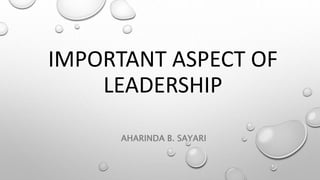
Important Aspect of Leadership.pptx
- 1. IMPORTANT ASPECT OF LEADERSHIP AHARINDA B. SAYARI
- 2. WHAT ARE THE IMPORTANT ASPECT OF LEADERSHIP?
- 3. 1. CHARACTER The mental and moral qualities distinctive to an individual.
- 4. Leaders must have integrity ,honesty and ethics. Good leaders must first learn to be good followers. Leaders do not dominate a group, but lead by their actions.
- 5. 2.CHART THE COURSE Share a vision with a plan If you do not know how to chart a course, ask for help.
- 6. 3. COMPETENCE TO EXPERTISE Continuous learning is necessary for a leader and a team.
- 7. WHAT YOU CAN DO Build your leadership skills Mastery Speaking and listening Understanding people Persuasion
- 8. Learn from mentors Read Observe Listen Practice learning by doing
- 9. 4.CHALLENGE AND CREATE Knowing your people – a good leader knows his or her team better than anyone else, their strengths, their weaknesses, what makes them tick and what motivates them.
- 10. COMMUNICATION Communicating effectively, listening actively, working with people and helping others work together in groups.
- 11. THEORIES ON LEADERSHIP Leadership has been described as the "process of social influence in which one person is able to enlist the aid and support of others in the accomplishment of a common task" .A definition more inclusive of followers comes from Alan Keith of Genentech who said "Leadership is ultimately about creating a way for people to contribute to making something extraordinary happen," Students of leadership have produced theories involving traits, situational interaction, function, behavior, power, vision and
- 12. Although trait theory has an intuitive appeal, difficulties may arise in proving its tenets, and opponents frequently challenge this approach. The "strongest" versions of trait theory see these "leadership characteristics" as innate, and accordingly labels some people as "bom leaders" due to their psychological makeup. On this reading of the theory, leadership development involves identifying and measuring leadership qualities, screening potential leaders from non-leaders, then
- 13. BEHAVIORAL AND STYLE THEORY In response to the criticism of the trait approach, theorists began to research leadership as a set of behaviors, evaluating the behavior of 'successful' leaders, determining a behavior taxonomy and identifying broad leadership styles. David McClelland, for example, saw leadership skills, not so much as a set of traits, but as a pattern of motives. He claimed that successful leaders will tend to have a high need for power, a low need for
- 14. TRAIT THEORY Trait theory tries to describe the types of behavior and personality tendencies associated with effective leadership. This is probably the first academic theory of leadership. Thomas Carlyle (1841) can be considered one of the pioneers of the trait theory, using such approach to identify the talents, skills and physical characteristics of men who arose to power. Ronald Heifetz (1994) traces the trait theory approach back to the nineteenth-century tradition of associating the history of society to the history of great men.
- 15. THE MANAGERIAL GRID MODEL THEORY In each, the leader exercised his influence regarding the type of group decision making, praise and criticism (feedback), and the management of the group tasks (project management) according to three styles: (1) authoritarian, (2) democratic and (3) laissez-faire. Authoritarian climates were characterized by leaders who make decisions alone, demand strict compliance to his orders, and dictate each step taken; future steps were uncertain to a large degree.
- 16. SITUATIONAL AND CONTINGENCY THEORY According to the theory, "what an individual actually does when acting as a leader is in large part dependent upon characteristics of the situation in which he fianctions." Some theorists started to synthesize the trait and situational approaches. Building 50 upon the research of Lewin et.al, academics began to normaUze the descriptive models of leadership climates, defining three leadership styles and identifying in which situations
- 17. FUNCTIONAL THEORY This theory argues that the leader's main job is to see that whatever is necessary to group needs is taken care of; thus, a leader can be said to have done their job well when they have contributed to group effectiveness and cohesion (Fleishman et al., 1991; Hackman & Wageman, 2005; Hackman & Walton, 1986). While functional leadership theory has most often been applied to team leadership (Zaccaro, Rittman, & Marks, 2001), it has also been effectively applied to broader organizational leadership as well (Zaccaro, 2001).
- 18. TRANSACTIONAL AND TRANSFORMATIONAL THEORY The transactional leader (Bums, 1978) is given power to perform certain tasks and reward or punish for the team's performance. It gives the opportunity to the manager to lead the group and the group agrees to follow his lead to accomplish a predetermined goal in exchange for something else. Power is given to the leader to evaluate, correct and train subordinates when productivity is not up to the desired level and reward effectiveness when
- 19. The transformational leader (Bums, 2008) motivates its team to be effective and efficient. Communication is the base for goal achievement focusing the group on the final desired outcome or goal attainment. This leader is highly visible and uses chain of command to get the job done. Transformational leaders focus on the big picture, needing to be surrounded by people who take care of the details. The leader is always looking for ideas that move the organization to reach the company's vision.
- 20. REFERENCES https://talentbridge.com Mr. Bong Asperin Webster Dictionary
- 21. Thank you…